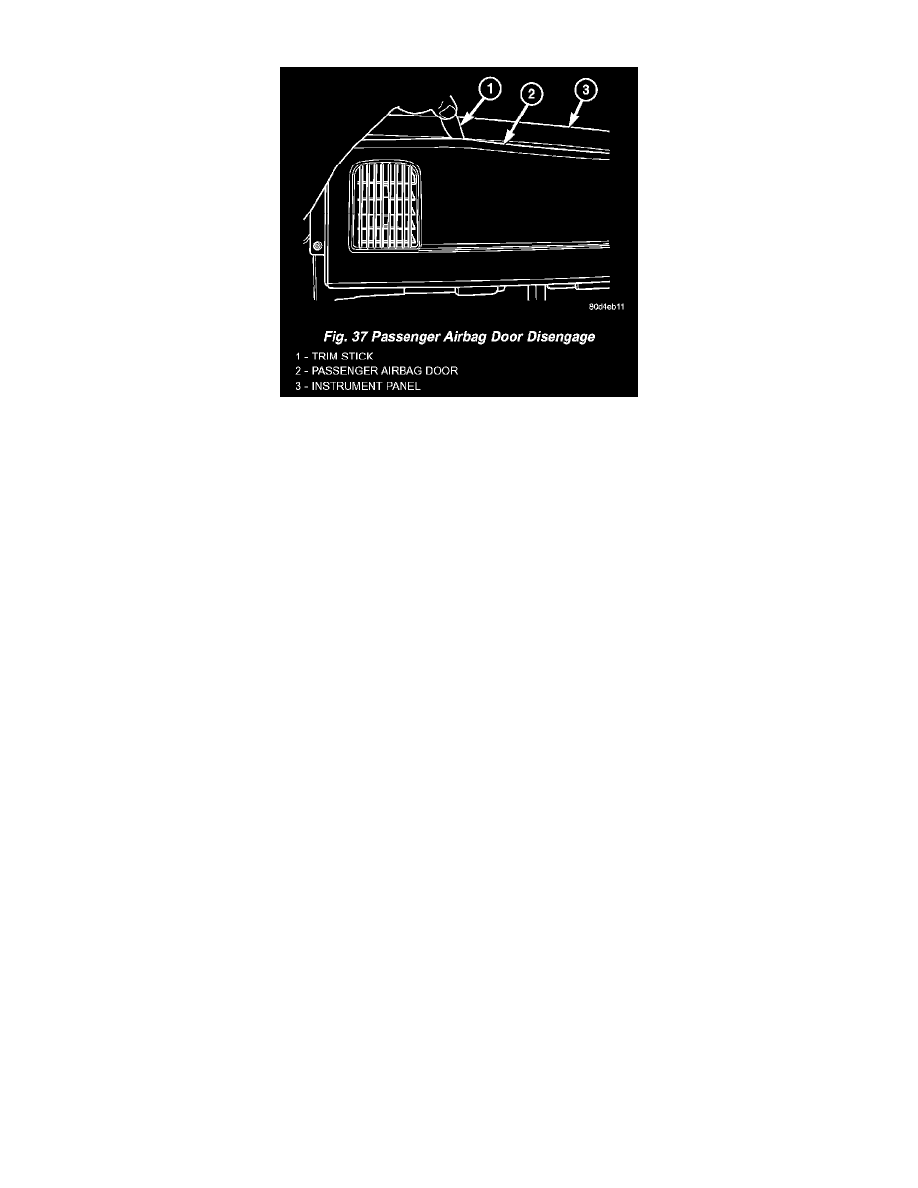RAM 1500 Truck 4WD V8-5.9L VIN Z (2002)

instrument panel structural support.
Fig. 37 Passenger Airbag Door Disengage
7. Using a trim stick or another suitable wide flat-bladed tool, gently pry the upper and outboard edges of the passenger airbag door away from the
instrument panel far enough to disengage the seven snap features on the door from the receptacles in the instrument panel base trim.
8. Pull the passenger airbag housing and door unit straight back from the instrument panel far enough to access the instrument panel wire harness
take out and connector for the airbag inflator located on the inboard side of the housing.
9. Disconnect the instrument panel wire harness connector for the passenger airbag from the connector receptacle on the airbag inflator.
10. Remove the passenger airbag and airbag door from the instrument panel as a unit.
INSTALLATION
The following procedure is for replacement of a faulty or damaged passenger airbag. If the airbag is faulty or damaged, but not deployed, review the
recommended procedures for handling non-deployed supplemental restraints. (Refer to RESTRAINTS - STANDARD PROCEDURE - HANDLING
NON-DEPLOYED SUPPLEMENTAL RESTRAINTS). If the passenger airbag has been deployed, review the recommended procedures for service
after a supplemental restraint deployment before removing the airbag from the vehicle. (Refer to RESTRAINTS - STANDARD PROCEDURE -
SERVICE AFTER A SUPPLEMENTAL RESTRAINT DEPLOYMENT).
WARNING
-
ON VEHICLES EQUIPPED WITH AIRBAGS, DISABLE THE SUPPLEMENTAL RESTRAINT SYSTEM BEFORE ATTEMPTING
ANY STEERING WHEEL, STEERING COLUMN, DRIVER AIRBAG, PASSENGER AIRBAG, SEAT BELT TENSIONER, SIDE
CURTAIN AIRBAG, OR INSTRUMENT PANEL COMPONENT DIAGNOSIS OR SERVICE. DISCONNECT AND ISOLATE THE
BATTERY NEGATIVE (GROUND) CABLE, THEN WAIT TWO MINUTES FOR THE SYSTEM CAPACITOR TO DISCHARGE
BEFORE PERFORMING FURTHER DIAGNOSIS OR SERVICE. THIS IS THE ONLY SURE WAY TO DISABLE THE
SUPPLEMENTAL RESTRAINT SYSTEM. FAILURE TO TAKE THE PROPER PRECAUTIONS COULD RESULT IN
ACCIDENTAL AIRBAG DEPLOYMENT AND POSSIBLE PERSONAL INJURY.
-
WHEN REMOVING A DEPLOYED AIRBAG, RUBBER GLOVES, EYE PROTECTION, AND A LONG-SLEEVED SHIRT SHOULD
BE WORN. THERE MAY BE DEPOSITS ON THE AIRBAG UNIT AND OTHER INTERIOR SURFACES. IN LARGE DOSES,
THESE DEPOSITS MAY CAUSE IRRITATION TO THE SKIN AND EYES.
-
USE EXTREME CARE TO PREVENT ANY FOREIGN MATERIAL FROM ENTERING THE PASSENGER AIRBAG, OR
BECOMING ENTRAPPED BETWEEN THE PASSENGER AIRBAG CUSHION AND THE PASSENGER AIRBAG DOOR. FAILURE
TO OBSERVE THIS WARNING COULD RESULT IN OCCUPANT INJURIES UPON AIRBAG DEPLOYMENT.
1. Position the passenger airbag and airbag door to the instrument panel as a unit.
2. Reconnect the instrument panel wire harness connector for the passenger airbag to the connector receptacle on the airbag inflator. Be certain that
the connector latches are fully engaged.
3. Position the passenger airbag housing and door unit into the instrument panel.
4. Using hand pressure, press firmly and evenly over each of the seven snap features on the upper and outboard edges of the passenger airbag door
until they snap into the receptacles in the instrument panel base trim.
5. Reach through and above the glove box opening to install and tighten the two screws that secure the passenger airbag front brackets to the
instrument panel structural support. Tighten the screws to 6 Nm (55 in. lbs.).
6. Reach through and above the glove box opening to install and tighten the two screws that secure the passenger airbag rear brackets to the upper
glove box opening reinforcement. Tighten the screws to 6 Nm (55 in. lbs.).
7. Install and tighten the six screws that secure the inboard and lower flanges of the passenger airbag door to the instrument panel. Tighten the screws
to 2 Nm (20 in. lbs.).
